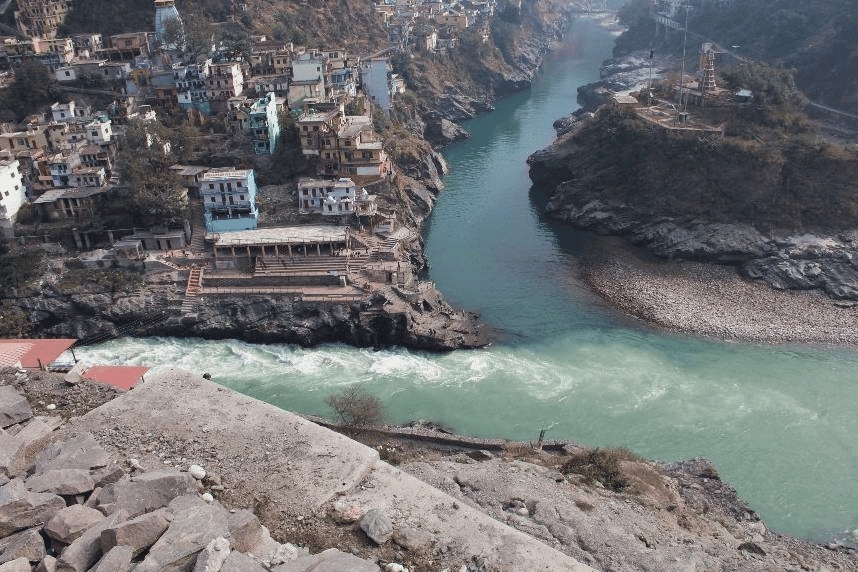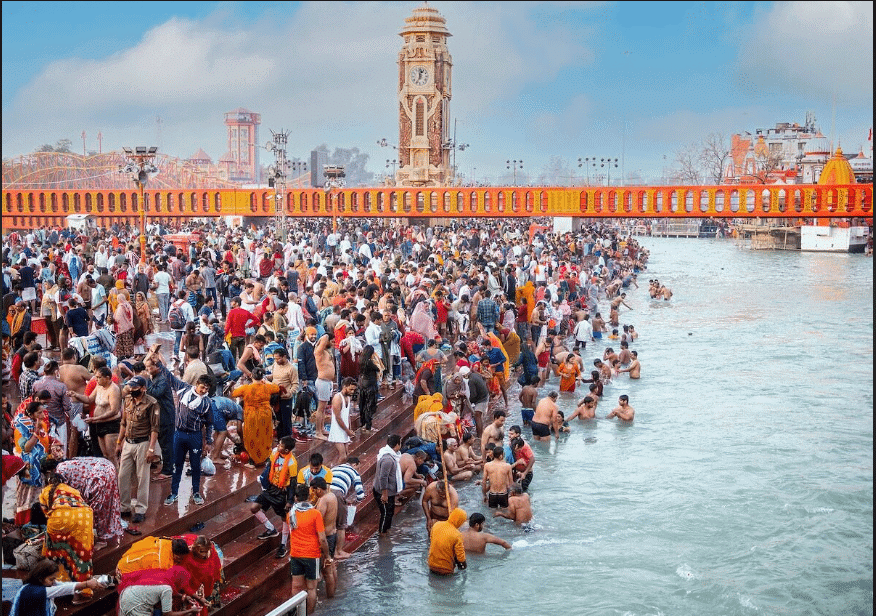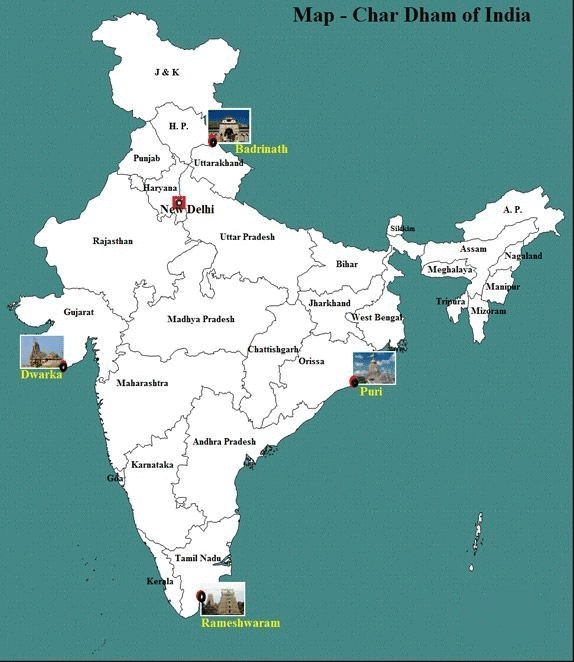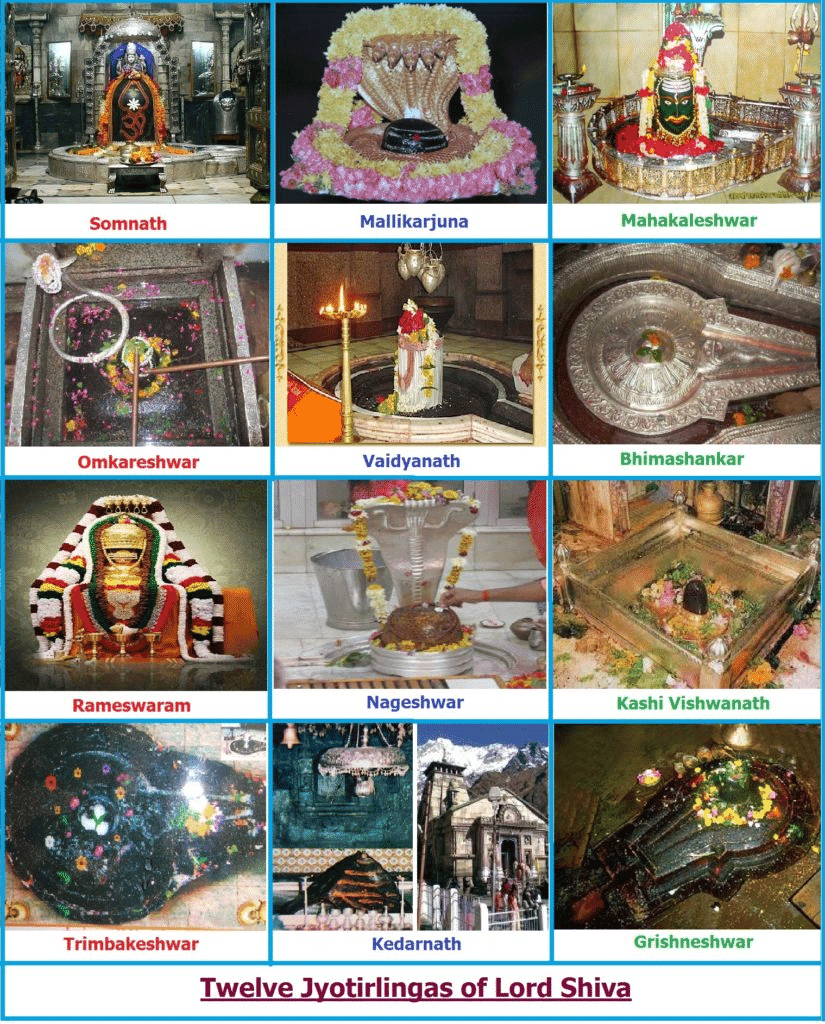Class 7 Social Science Chapter 8 Question Answers - How the Land Becomes Sacred
Short Answer Questions
Q1: How does the concept of sacred geography connect people across India?
Ans: Sacred geography connects people by linking pilgrimage sites and sacred spaces, fostering cultural exchanges and shared spiritual values. Pilgrims traveling to these sites from different regions encounter diverse traditions but share common religious goals.
Q2: What role do rivers play in sacred geography?
Ans: Rivers are considered divine in sacred geography, with many being worshipped as goddesses. Rituals are performed at riverbanks, and places like the Ganga and Yamuna are seen as lifelines for both spiritual and physical sustenance.
 Sangam of Rivers
Sangam of Rivers
Q3: Why is the Char Dhām Yātrā significant?
Ans: The Char Dhām Yātrā, consisting of four pilgrimage sites in different parts of India, is significant as it connects the northern, southern, eastern, and western regions, promoting unity and spiritual growth across diverse cultures.
Q4: How does sacred ecology contribute to environmental preservation?
Ans: Sacred ecology links spiritual beliefs with nature conservation by encouraging the protection of rivers, mountains, and forests. By viewing nature as sacred, communities feel responsible for preserving these spaces from harm or exploitation.
Q5: What is the story behind the Shakti Pithas?
Ans: The Shakti Pithas are sacred sites where the body parts of Sati, the divine mother, are believed to have fallen after Vishnu cut her body. These sites are revered as places of worship for the goddess Shakti.
Q6: How does the Kumbh Mela reflect the significance of sacred geography?
Ans: The Kumbh Mela, held at four sacred river sites, reflects sacred geography by bringing millions together to bathe in the holy rivers. It’s an event that connects various regions of India through shared religious practices and beliefs.
 Kumbh Mela
Kumbh Mela
Q7: What is the significance of sacred groves in India?
Ans: Sacred groves are protected forests, often associated with deities, and serve as a way to conserve biodiversity. They play an important role in maintaining the ecological balance by preserving unique plant and animal species.
Q8: How do trees, like the peepul, feature in sacred geography?
Ans: In sacred geography, trees like the peepul are considered sacred, with religious and spiritual significance. The peepul tree, especially at Bodh Gaya, is associated with Buddha’s enlightenment and is revered in Hinduism, Buddhism, Sikhism, and Jainism.
Q9: How did pilgrimage routes overlap with trade routes in ancient India?
Ans: Pilgrimage routes often overlapped with trade routes, facilitating not just religious journeys but also the exchange of goods, ideas, and culture, enriching both spiritual and economic life.
Q10: Why is the Ganga river considered sacred in Hinduism?
Ans: The Ganga river is considered sacred in Hinduism because it is believed to be a goddess who purifies souls. Pilgrims bathe in the river to cleanse their sins and seek spiritual liberation.
Q11: How do sacred mountains relate to religious beliefs?
Ans: Sacred mountains, like the Himalayas, are believed to be gateways to heaven. Many pilgrimage sites are located at mountain peaks, symbolizing the physical and spiritual journey to divine realms.
Q12: What impact has pollution had on sacred sites in India?
Ans: Pollution has harmed sacred sites, like rivers and temples, leading to a strained relationship between people and nature. The pollution of holy rivers like the Yamuna and Ganga disrupts spiritual practices and threatens the sanctity of these sites.
 Char Dham
Char Dham
Long Answer Questions
Q1: How do pilgrimage routes and sacred geography contribute to cultural unity in India?
Ans:
- Pilgrimage routes and sacred geography contribute to cultural unity by connecting different regions through shared religious journeys.
- As people travel to sacred sites like the Char Dhām or Kumbh Mela, they encounter diverse customs and traditions, but also uphold shared values of reverence for nature and spirituality.
- This exchange of culture strengthens India's unity by bridging regional differences and fostering a common religious identity.
Q2: What is the concept of sacred ecology, and how does it relate to environmental conservation?
Ans:
- Sacred ecology refers to the belief that natural elements like rivers, mountains, and forests are sacred and should be protected due to their spiritual significance.
- This belief encourages communities to preserve and protect the environment, as they view these natural elements as divinely sacred.
- Sacred ecology blends spirituality and environmental conservation, ensuring that these natural resources are treated with reverence and care for future generations.
Q3: How do sacred sites like the Ganga River and the Himalayas connect nature with spirituality in India?
Ans:
- Sacred sites like the Ganga River and the Himalayas are seen as divine entities in Hinduism, with the Ganga considered a goddess and the Himalayas a gateway to heaven.
- Pilgrims travel to these places not only for spiritual purification but also to connect with the natural world.
- The belief that nature itself is sacred fosters a deep connection between religious practices and the preservation of these natural landscapes.
Q4: Describe the importance of the Kumbh Mela in shaping India’s religious and cultural landscape.
Ans:
- The Kumbh Mela is one of the largest religious gatherings in the world, where millions of pilgrims gather at sacred river confluences to bathe and cleanse themselves spiritually.
- This pilgrimage is deeply rooted in India’s religious and cultural identity, as it reflects the importance of sacred geography, rituals, and unity.
- The Kumbh Mela not only highlights the sacredness of the rivers but also strengthens communal bonds across different regions of India through shared religious practices.
Q5: How does the concept of sacred groves contribute to biodiversity conservation?
Ans:
- Sacred groves are protected forests that are revered as homes of deities in various Indian cultures.
- These groves are a vital part of biodiversity conservation, as they preserve unique species of plants, animals, and ecosystems.
- Since these groves are protected by local communities, they offer a sanctuary for endangered species and play a crucial role in maintaining ecological balance, while also fostering a sense of reverence for nature.
Q6: What is the significance of the Shakti Pithas and Jyotirlingas in Hinduism?
Ans:
- The Shakti Pithas and Jyotirlingas are sacred sites dedicated to the goddess Shakti and Lord Shiva, respectively.
- The Shakti Pithas are believed to be locations where the body parts of Sati, the divine consort of Shiva, fell, while the Jyotirlingas represent sacred shrines of Shiva.
- Both these sites are central to Hindu spirituality, with pilgrims visiting them to seek blessings, spiritual purification, and divine protection.
 Jyotirlingas
Jyotirlingas
Q7: How does the sacredness of rivers like the Yamuna and Kaveri influence local communities?
Ans:
- Rivers like the Yamuna and Kaveri are considered sacred in India, and their sanctity influences local communities in many ways.
- People often perform rituals, prayers, and festivals along the banks of these rivers, believing that the water holds purifying power.
- Communities that depend on these rivers for their livelihoods, like fishing or farming, also maintain strong cultural practices that protect and preserve the river, reinforcing the sacred bond between the people and the land.
Q8: Explain the impact of sacred geography on India's cultural diversity and unity.
Ans:
- Sacred geography in India plays a significant role in promoting cultural diversity and unity by providing shared spaces for religious practices.
- Sites like the Char Dhām, Kumbh Mela, and various pilgrimage routes bring together people from different regions, languages, and traditions.
- Although these pilgrims come from diverse backgrounds, they are united by their respect for sacred places and their common belief in the divine power of nature and geography, creating a sense of national unity through shared religious values.
|
23 videos|204 docs|12 tests
|
FAQs on Class 7 Social Science Chapter 8 Question Answers - How the Land Becomes Sacred
| 1. What are the main factors that contribute to the land becoming sacred? |  |
| 2. How does the community play a role in recognizing sacred land? |  |
| 3. Can sacred land change over time and why? |  |
| 4. What impact do sacred lands have on local cultures and identities? |  |
| 5. How can individuals contribute to the preservation of sacred lands? |  |
















